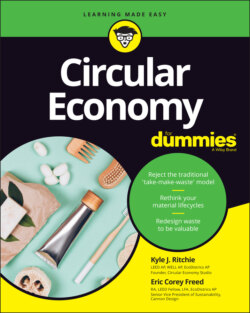Читать книгу Circular Economy For Dummies - Eric Corey Freed - Страница 43
We don’t have as much as we thought
ОглавлениеIn addition to having a finite number of planetary resources and a growing demand from an ever-increasing population, it turns out that what we thought was an endless supply isn’t endless at all.
Our global natural resources are depleting by 45 percent every year. The United Nations reports that soil degradation was proceeding so quickly that only 60 harvests might remain until food supplies severely decline. Our water supplies are constrained; most of the water is in the oceans or undrinkable, and another 2 percent is frozen in the polar ice caps, leaving only 1 percent left for people to drink as a freshwater supply. Unfortunately, 70 percent of that supply is polluted.
Look at the planet’s dwindling resources:
Water: By 2025, 1.8 billion people won’t have access to clean drinking water.
Coal: Though the planet has a large enough supply of coal reserves to last until the year 2200, if we burn that supply, it will release so much in carbon emissions that it will radically transform the climate. In the next decade, scientists expect that the earth will hit peak coal — or the point at which coal production reaches its maximum rate and drops every year afterward.
Oil: The earth hit peak oil back around 2003 or so, and scientists estimate that we have only enough oil in the ground to last another 45 years (at the current level of demand).
Natural gas: Known reserves will last only until 2075 or so, and supplies of new gas sources are growing scarce.
Wood: Deforestation causes around 8.2 million acres to be lost every year, contributing 15 percent of global greenhouse gas emissions. (Trees absorb carbon dioxide, in case you forgot.) An area of forest the size of Italy disappeared in 2020.
The pressures on our natural resources, combined with population growth, are driving the need to change our linear economic models.
